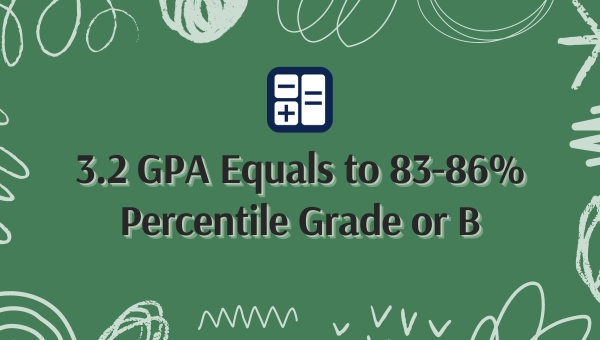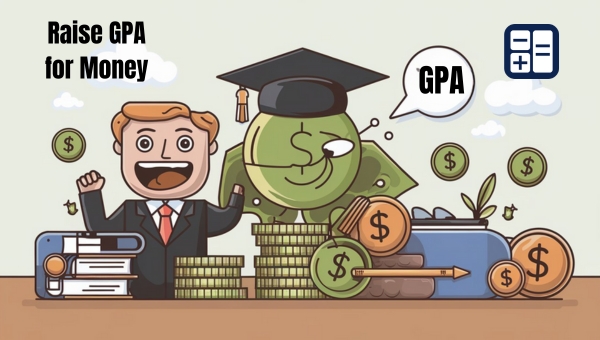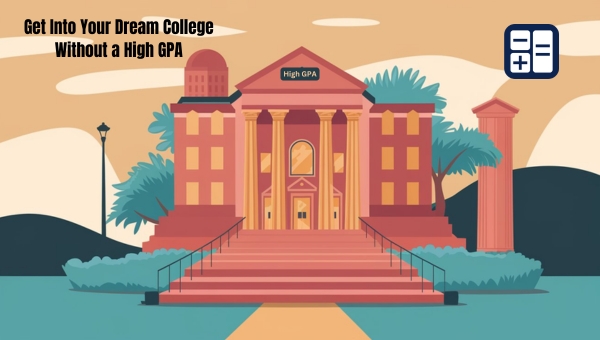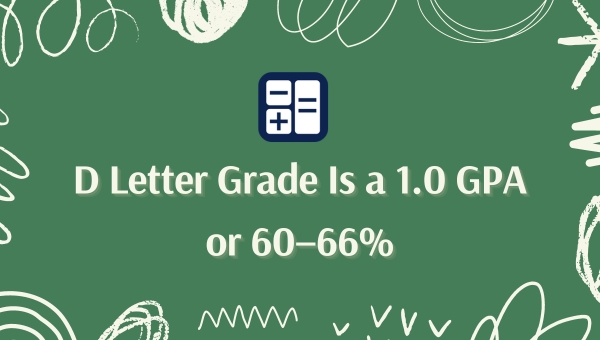3.2 GPA Equals to 83-86% Percentile Grade or B

You’re probably aware that a 3.2 GPA translates to an 83-86% percentile grade, typically a B. But what does this really mean for high school students aiming for college or scholarships? This GPA shows you’re doing well, but there’s always the potential for growth.
It’s crucial to understand how this affects your academic prospects and what steps you can take to either maintain or improve your grades. So, how can you strategically work towards raising your GPA quickly and effectively?
What is a 3.2 GPA?
When you’re looking at a 3.2 GPA, it’s important to understand what it signifies about academic performance. A 3.2 GPA generally falls within the B range, translating to a percentage grade between 83% and 86%. This places you above average, indicating consistent performance and a solid understanding of the coursework.
A GPA of 3.2 suggests that you’ve been diligent in your studies, but there’s room for improvement. It’s not the highest score, but it’s respectable and shows that you have a good grasp of most of the material.
This GPA can open doors to various opportunities, including scholarships and acceptance into many colleges, though it might limit access to the most competitive programs.
Understanding your GPA also helps you set realistic goals. If you’re aiming to improve, you might focus on specific subjects where you have more difficulty. Conversely, if you’re content with your performance, a 3.2 GPA shows you’re on a stable path.
What does a 3.2 GPA mean for high school students?
With a 3.2 GPA, you might be wondering how it impacts your college options. You’ll likely find that some colleges fall into the category of safety schools, while others are more challenging target schools. Dream schools might require a bit higher GPA, but don’t let that discourage you from applying.
Safety Schools
For high school students, a 3.2 GPA signifies a solid academic performance but mightn’t be competitive for the most selective colleges. However, there are many great options available where you can thrive academically and socially.
These are often referred to as “safety schools”—colleges where your GPA and other qualifications exceed the average admitted student’s profile.
When considering safety schools, keep in mind the following:
- Acceptance Rates: These schools typically have higher acceptance rates, giving you a better chance of admission.
- Academic Programs: They offer robust academic programs that can still provide a quality education and valuable opportunities.
- Location: You might find them in various locations, from bustling cities to serene rural areas, offering a range of environments to suit your preferences.
- Cost: Safety schools often have more affordable tuition rates or generous financial aid packages.
- Campus Culture: You can find vibrant campus communities with diverse extracurricular activities, allowing you to engage and grow outside of the classroom.
Target Schools
A 3.2 GPA places you in a solid middle ground when it comes to college admissions, often aligning you with target schools.
These are institutions where your academic profile matches well with the average admitted student, giving you a decent chance of acceptance. A 3.2 GPA translates to around 83-86% on a percentile scale, which is respectable but not exceptional.
When considering target schools, keep in mind that they typically have certain characteristics:
- Moderate selectivity: These schools have moderate acceptance rates, meaning they’re neither too easy nor too hard to get into.
- Balanced academic profile: Your GPA and test scores should align closely with their admitted students’ averages.
- Program diversity: They often offer a wide range of majors and programs, providing flexibility in your academic pursuits.
- Supportive environment: These institutions usually have resources to help students succeed, such as tutoring centers and academic advising.
- Accessible extracurriculars: With a solid GPA, you’ll find many opportunities to engage in clubs, sports, and other activities.
Dream Schools
While target schools offer a balanced and supportive environment, many high school students still set their sights on dream schools, even with a 3.2 GPA.
You might wonder if a 3.2 GPA, which translates to an 83-86% percentile grade or a B, can get you into your dream university. The good news is that your GPA doesn’t have to define your future entirely.
Dream schools consider more than just grades. They look at:
- Extracurricular activities: Showcase your leadership and commitment.
- Standardized test scores: Strong SAT or ACT scores can boost your application.
- Personal essays: Tell your unique story and explain your passion.
- Letters of recommendation: Choose people who know you well and can vouch for your abilities.
- Interviews: Prepare to articulate why you’re a good fit for the school.
Your academic performance is important, but it’s not the only factor. Admissions teams want well-rounded individuals who contribute to their community.
Proven Tips to Get a 3.2 GPA
To achieve a 3.2 GPA, focus on effective study techniques and manage your time wisely.
Make the most of campus resources and seek academic support when needed.
Don’t forget to prioritize your mental health to maintain a balanced and productive academic life.
Effective Study Techniques
Achieving a 3.2 GPA might seem daunting, but with effective study techniques, it’s entirely within your reach. Start by creating a dedicated study space free from distractions. This helps your brain associate that area with focused work.
Next, break your study sessions into manageable chunks. Use the Pomodoro Technique: study for 25 minutes, then take a 5-minute break. This keeps you fresh and increases retention.
Active learning is crucial. Don’t just passively read your notes; engage with the material. Summarize what you’ve learned in your own words, teach it to someone else, or create mind maps to visualize connections.
Practice problems are your best friends, especially in subjects like math and science. They help reinforce concepts and highlight areas where you need more review.
Utilize resources like study groups and office hours. Discussing material with classmates can provide new insights and understanding. Additionally, attending office hours gives you direct access to your professors for clarifying doubts.
Lastly, review regularly instead of cramming. Consistent, spaced repetition solidifies knowledge far better than last-minute studying.
Implement these techniques, and you’ll find that achieving a 3.2 GPA isn’t only possible but also manageable.
Time Management Strategies
Mastering time management is often essential for achieving a 3.2 GPA. First, create a weekly schedule. Break down your study sessions, class times, and personal commitments. Use a planner or digital calendar to visualize your week. This helps you allocate sufficient time for each subject without feeling overwhelmed.
Next, prioritize tasks. Identify what’s most urgent and important, and tackle those assignments first. Use the Eisenhower Matrix to differentiate between urgent and non-urgent tasks, ensuring you focus on what really matters.
Break your study time into manageable chunks using the Pomodoro Technique. Study for 25 minutes, then take a 5-minute break. After four cycles, take a longer break. This method helps maintain focus and prevents burnout.
Avoid multitasking. Concentrate on one task at a time to enhance efficiency and comprehension. Multitasking can reduce the quality of your work and increase the time required to complete tasks.
Finally, set realistic goals. Break large projects into smaller, achievable tasks. This makes daunting assignments feel more manageable and provides a sense of accomplishment as you complete each step.
Implement these strategies, and you’ll find time management becoming a key ally in your quest for a 3.2 GPA.
Utilize Campus Resources
When striving for a 3.2 GPA, don’t overlook the wealth of resources available right on your campus. Take advantage of the library’s vast collection of textbooks, journals, and online databases. These resources can supplement your coursework and deepen your understanding of challenging subjects. Libraries often offer quiet study spaces, perfect for focused study sessions.
You should also check out the writing center. They provide invaluable help with essays, research papers, and other writing assignments. Trained tutors can guide you through brainstorming, structuring your paper, and refining your arguments, ensuring you submit high-quality work each time.
Don’t forget about your professors’ office hours. Professors appreciate students who actively seek help and clarification. Meeting with them can provide insights you mightn’t get in class, and they can offer guidance on how to approach your studies effectively.
Additionally, many campuses have workshops and seminars on various academic skills, like note-taking, time management, and exam preparation. Attending these can provide you with strategies to improve your academic performance.
Lastly, use study groups to your advantage. Collaborating with classmates can give you different perspectives on the material and help reinforce your learning.
Seek Academic Support
Even if you’re feeling overwhelmed, seeking academic support is a crucial step towards maintaining or boosting your GPA to a 3.2. Start by visiting your professors during their office hours. They can provide valuable insights into difficult concepts and guide you on what to focus on for exams.
Don’t hesitate to ask questions—professors appreciate students who are proactive about their education.
Next, consider joining study groups. Collaborating with classmates can help you gain different perspectives on the material, and explaining concepts to others can reinforce your own understanding.
If a study group isn’t available, create one. You’ll find that teamwork often leads to better retention of information.
Tutoring services are another excellent resource. Many colleges offer free tutoring for a variety of subjects.
Tutors can provide personalized help and adapt their teaching methods to suit your learning style. Look into both peer tutoring and professional tutoring options.
Prioritize Mental Health
Balancing academics with mental health is essential for achieving a 3.2 GPA. You can’t ignore the stress and pressure that come with your studies. Prioritize mental health by setting boundaries. It’s okay to say no to extra responsibilities that could overwhelm you.
Ensure you’re getting enough sleep. Lack of rest impacts your focus and performance. Aim for 7-9 hours each night.
Incorporate regular breaks into your study routine. Step away from your desk, stretch, or take a brief walk. These small actions can refresh your mind and boost productivity.
Practice mindfulness or meditation. A few minutes each day can reduce anxiety and improve concentration. You’ll find it easier to tackle challenging subjects.
Connect with supportive friends and family. Don’t isolate yourself; sharing your experiences can lighten your mental load. If you’re feeling overwhelmed, seek professional help. Many schools offer counseling services, and talking to a professional can provide valuable coping strategies.
Maintain a balanced diet and stay hydrated. Good nutrition fuels your brain, helping you stay alert and focused.
How to Raise Your GPA Fast?
Raising your GPA quickly requires focused effort and strategic planning. First, identify your weakest subjects and dedicate extra time to them. Utilize resources like tutoring centers, study groups, and online tutorials. Don’t hesitate to ask for help from teachers; they can provide valuable insights and extra credit opportunities.
Second, organize your time effectively. Create a study schedule and stick to it. Prioritize tasks based on deadlines and difficulty. Use productivity techniques like the Pomodoro method to keep your mind fresh and focused.
Third, improve your note-taking skills. Effective notes are concise, well-organized, and highlight key concepts. Review your notes regularly instead of cramming right before exams. This helps reinforce the material and reduces stress.
Fourth, actively participate in class. Engage in discussions, ask questions, and complete all assignments on time. Participation can sometimes boost your grade, and staying engaged helps you understand the material better.
Lastly, take care of your physical and mental health. Adequate sleep, nutrition, and exercise improve concentration and memory. Avoid burnout by taking regular breaks and practicing relaxation techniques.
Conclusion
A 3.2 GPA indicates you’re performing above average, with room for improvement. For high school students, this GPA can open doors to scholarships and college admissions. Focus on proven strategies to maintain or boost your GPA, like staying organized and seeking help when needed.
Remember, consistent effort and a positive attitude can make a significant difference. Keep pushing yourself, and you’ll see your academic goals become more attainable.




